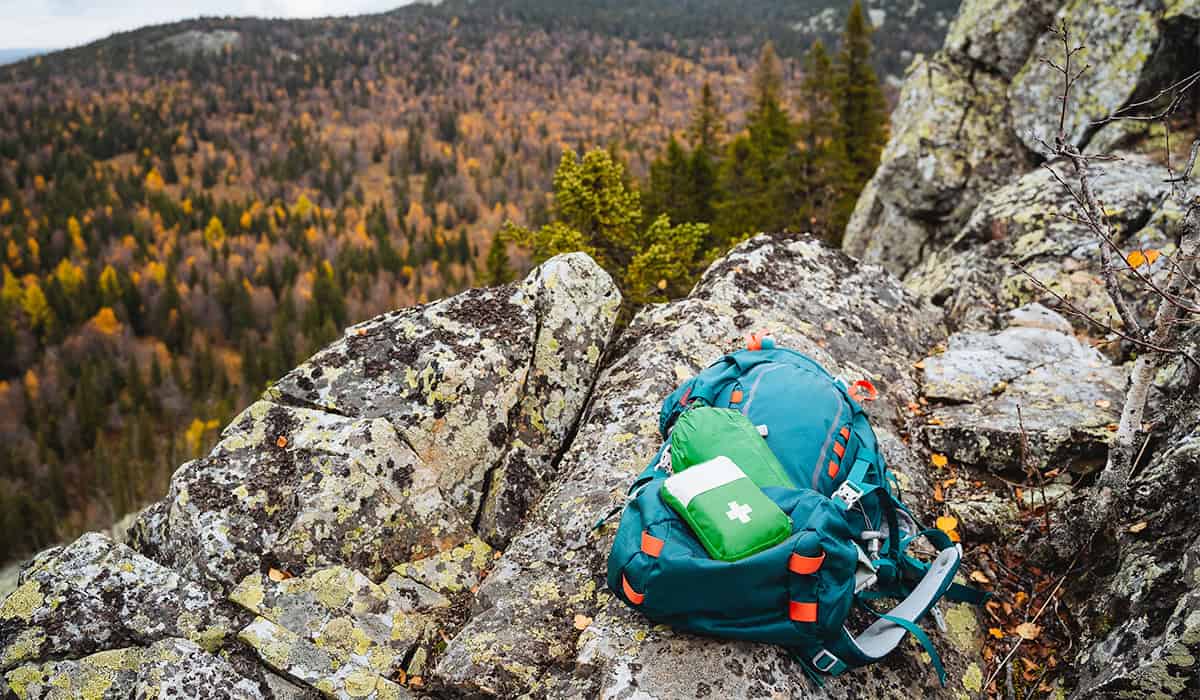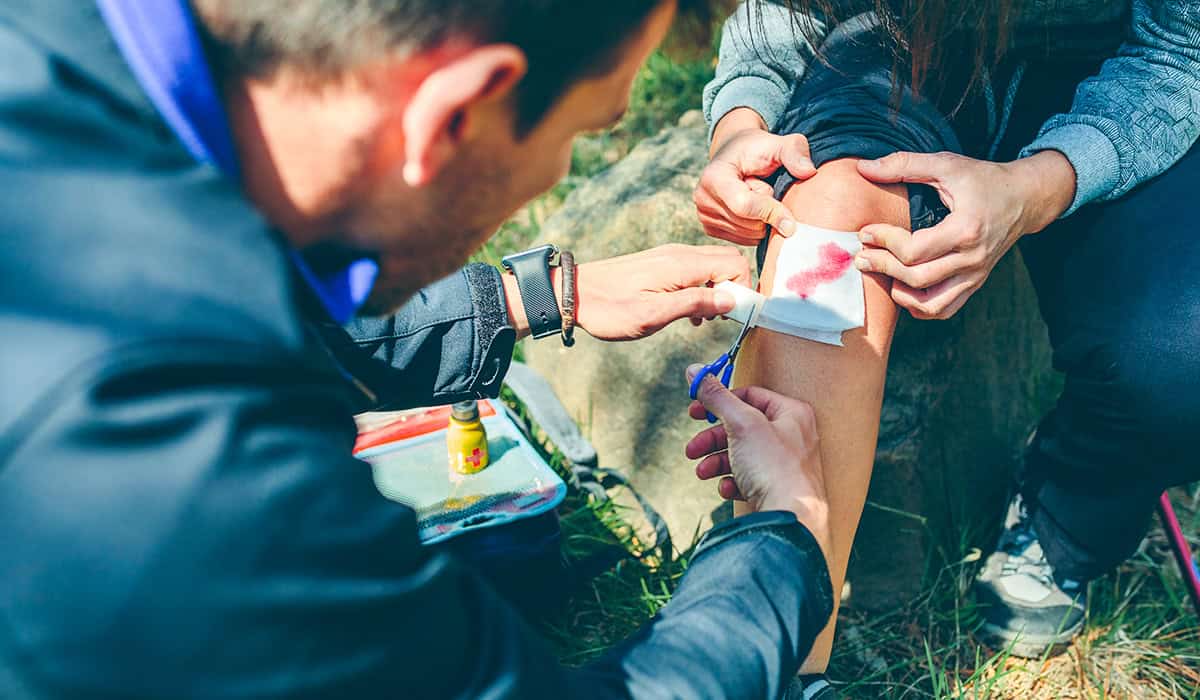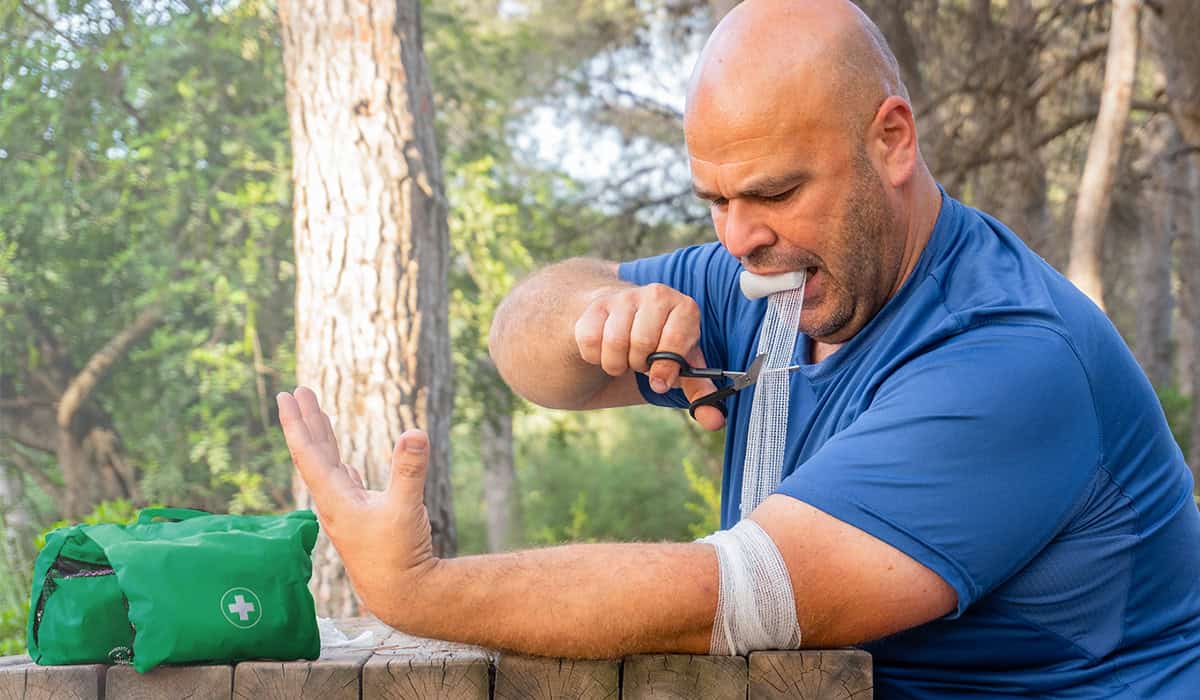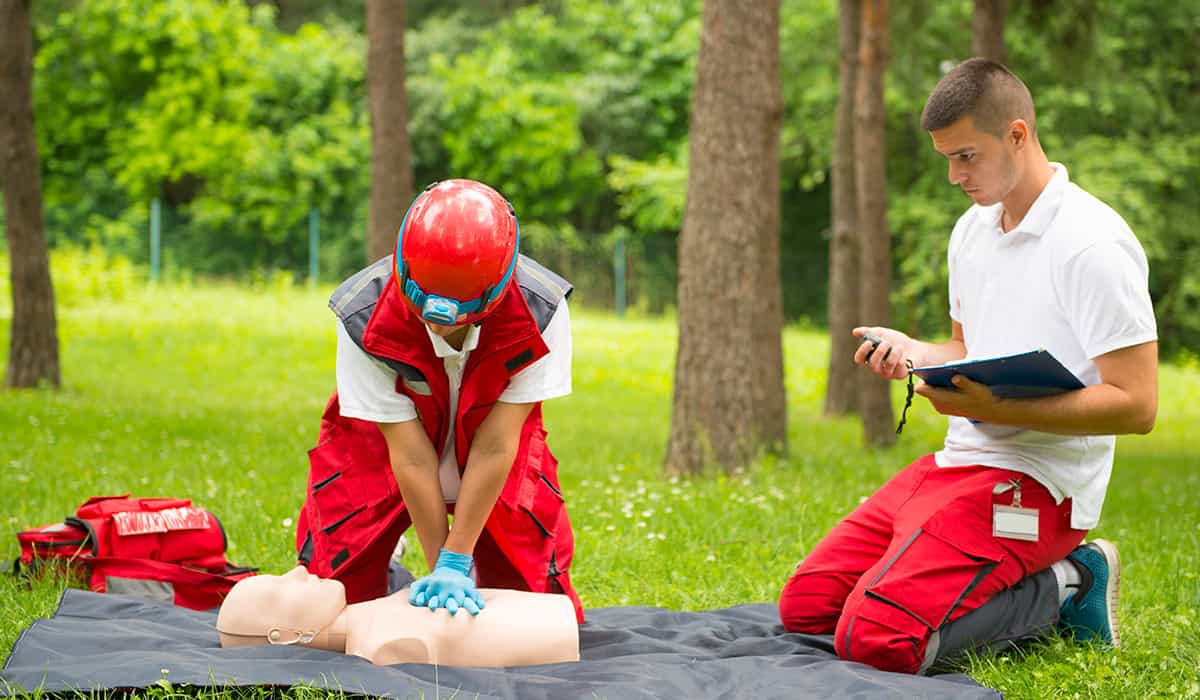
No matter your reason for being outdoors, whether you are a hiker, a teacher with a class of students or an expedition leader, you need to have an understanding of outdoor first aid and the challenges it can pose.
Unlike indoor environments, outdoor settings pose unique challenges that require a different approach to emergency care. Being prepared for common injuries and knowing how to respond effectively, especially in remote or high-risk areas, is critical, particularly if you're responsible for others. This article will help you gain insight into what precautions you need to take and how to treat common outdoor injuries.
Why outdoor first aid requires special consideration
There are many different factors that can influence first aid outdoors, one being the type of activity that is being undertaken, for example sports such as football or rugby, will have different common injuries to those that may be gained from a water activity. Similarly, the type of terrain can influence the severity of an injury or the type of risk, such as injury caused by an avalanche in a mountain area or a trip on a field.As such, special consideration needs to be taken when discussing outdoor first aid and what measures need to be taken. This is usually where the trip leader, be they a school teacher, a rescuer or expedition leader will conduct a risk assessment to determine what the highest risks are, how to negate them and how to handle them should they arise. This will influence the first aid supplies and equipment that is packed.
There is also no steady supply of clean water when you’re outdoors for the most part, so when providing first aid to keep the wound as clean as possible and avoid cross contamination. It is best to wear gloves or use antiseptic or antibacterial gel to clean your hands before providing first aid.
Key differences between outdoor and standard first aid

There are many differences between outdoor and standard first aid, not just the environment in which the casualty is being treated in, although that can have a great effect on hand hygiene and wound cleansing in general.
When outdoors, you will also need to consider the fading light, or how to signal your location if all other methods of communication have failed. This is why you should always carry a torch or potentially an emergency snaplight as they are lightweight and once activated should provide light for roughly 8 hours.
Below are three of the key differences that can impact first aid when it is being performed outdoors instead of indoors as is standard.
Limited access to emergency services
Depending on the type of outdoor activity you are undertaking, it can be a challenge for emergency services to reach the casualty. Particularly if you are in an area with difficult terrain.With standard first aid, particularly in the UK, it is assumed that further help will arrive within 8 minutes, however, when performing outdoor first aid, help will likely take longer to reach you. This means that there is a higher risk to the casualty, and the first aider needs to pay close attention to the steps necessary to keep them comfortable.
Improvisation with materials
When exploring the great outdoors, you will likely have a limited supply of first aid materials. Not everyone will have thought ahead or brought a full first aid kit with them on their adventure, particularly if they don’t plan to be out for very long.This is where your creativity and quick thinking come into play. In emergency situations outdoors you will only have the supplies you brought with you and what can be found in the surrounding area. For example, in some instances where a tourniquet hasn’t been available, first aiders have used sticks or other hard and sturdy instruments to twist a triangular bandage to restrict blood flow, or if there are no bandages available, using scraps of clothing as bandages to provide compression and wound dressing in emergency situations.
Communication challenges (no phone signal)
Currently, most people will have access to a mobile phone wherever they are, however, that doesn’t necessarily mean that there will be signal. Mountainous areas are particularly notorious for bad reception, but it can also be an issue in heavily wooded locations and on coastal paths.This could mean that there is a delay between when the accident happens and when the first aider or another member of the party is able to get in contact with someone who can help. It will also interfere with giving a firm location if you are unfamiliar with the area.
To minimise the risk of being left without communication, satellite phones are increasingly popular with outdoor enthusiasts and are also common in the public sector with search and rescue and the military. Satellite phones work by sending signals to communication satellites in space instead of relying on those on the ground.
There is also the OS app, which now includes a feature called “locate me”, which pinpoints a person’s GPS location on an Ordnance Survey map almost immediately. This means that if you were to need emergency services, you would be able to give your coordinates or OS reference grid to the responders straight away.
Common outdoor injuries and how to respond

A lot of outdoor pursuits will have pre-made first aid kits designed to facilitate quick responses to common outdoor injuries, although some people find that they prefer to build their own kits or add certain supplies for more comprehensive cover.
One of the most common outdoor injuries is blisters, caused by new or poorly fitting footwear. This is particularly common in those walking or running long distances, which is why most people will carry blister plasters with them for first aid as a minimum.
Other outdoor injuries include:
Cuts, grazes and wounds
Cuts, grazes and wounds are very common when you’re being active, especially outdoors, and one of the most important things to know when dressing these injuries is to ensure that they remain clean by removing any debris or contaminants from the wound.Superficial wounds are easily treated through the use of plasters, dressings and bandages. When packing an outdoor first aid kit, take into account the type of supplies they will require, for example, whether waterproof plasters would be better than fabric or if it would work better to include conforming bandages or crepe bandages.
If there is a concern about a limited amount of space within the bag, ensure that the dressings are adhesive, so can be used without a secondary bandage.
For larger wounds that may have life-threatening bleeding, there will need to be either a tourniquet to stop blood flow to the limb or haemostatic gauze to speed up the clotting process while you wait for help to arrive.
Sprains and fractures
As with almost all injuries, the most common when outside are slips, trips and falls. This is made worse in the winter months when there is a high probability of ice on the paths. The injuries that are gained as a result vary in severity from simple sprains and scrapes to fractures and head injuries.Sprains are particularly common in sporting activities, such as football and rugby, and can be treated using the PRICE method: Protect, Rest, Ice, Compression and Elevation.
Fractures, depending on the type, size and location, will require further medical intervention. If a member of your group were to fracture a bone while outdoors, follow these steps:
- Check for any danger
- Support the area and keep it as still as possible
- Control any external bleeding, but do not apply pressure to any bone protruding through the skin
- Cover any open wounds with sterile dressing and pack around any protruding bone
If you are unsure whether the bone is broken or if it is sprained, a splint can be used to hold the joint in place until professionals can examine the injury and advise on how to proceed.
Heatstroke and hypothermia
When you are outside in extreme weather conditions, there is the risk of heatstroke in hot weather and hypothermia in cold climates, which is why a foil blanket is recommended. Foil blankets are simple to use and versatile as they can trap heat to warm a casualty, or reflect heat to cool them down.When treating for hypothermia, the aim is to get the casualty warm and dry. This can be done with clothing, foil blankets, body heat, warm drinks and high energy food. It is important to remember not to warm the casualty too quickly, as this causes the blood vessels to dilate and can cause shock.
In contrast, heat stroke should be treated by cooling the casualty down, which can be achieved through moving to a cooler environment, removing excess clothing, fanning and foil blankets. Note that heat stroke is a serious condition that can lead to unresponsiveness, can be fatal and is caused when the body becomes too hot to sweat.
Insect bites and stings
For the most part, insect bites or stings can be treated with over-the-counter creams and antihistamines, although they can cause allergic reactions or become infected, so it is best to avoid scratching them and seek help if symptoms persist.When removing ticks the best method is to use tweezers. You will need to grasp the tick as close to your skin as possible with the tick remover and pull, try not to twist or squeeze the body as the head could get left behind.
Previously, the recommended approach for treating insect stings was similar to that for removing ticks, however, this should only be attempted if you are certain, you won’t squeeze the sting on removal because it will release further toxins into the blood stream. Instead, use a flat surface like the edge of a credit card and gently scrape the stinger off.
Tips for staying prepared in the wild

Staying prepared in the wild could very well save your life and the lives of those travelling with you. It is important that you know your route and communication plan and also have designated first aiders trained to react in an emergency.
It’s not just you who should be prepared, make sure that those travelling with you know how to react in extreme weather and emergency scenarios to minimise panic.
Know your route and communication plan
If an emergency does happen it is important to know the route you are taking. This is primarily so that if you or someone else gets separated from the group you will be able to find your way back to them by following the same path. This knowledge can also be used if there was an accident and emergency services needed to know your location. You could use your awareness of the route to provide that information to them or give a rough estimate.Knowing the communication plan is essential if you are following a route that will take you out of normal phone signal range. By ensuring you have a way of communicating not only with your fellow explorers, but emergency services and tracking the news for weather updates, you will be able to minimise the safety risks of exploring off the beaten track and be able to prepare should you need to evacuate or take shelter.
Another way to plan for communication failures, particularly in a group where not all participants will have phones to begin with is to use perry whistles. These will alert others to your location if you are lost or injured. Rescuers will be able to follow the sound to find you.
Assign a first aider in groups
Having a designated first aider for each group will save time and help to keep everyone safe.In some cases, like for school trips it is a legal requirement for there to be a first aider as a precaution. However, if the group were to split up, having multiple first aiders would mean that there wouldn’t be a delay in providing treatment if needed.
Practice scenario drills
While a primary first aider is important, it’s best to make sure that everyone is aware of what to do in an emergency. Practicing different scenarios with the group ensures that not only does everyone know what to expect and how to act, but it also makes it more likely that they will remember how to respond and not panic if the situation does come to pass.If you're in a large group or traveling with children, practicing what to do if someone gets separated and agreeing on a common meeting point can provide peace of mind and help ensure no one gets lost, even in an emergency.
Outdoor first aid training options

First aid training is ideal for any activity to ensure that you have the skills and confidence necessary to step in and help when an emergency happens. Having specific outdoor first aid training means that you can adjust what you are learning to have a heavier focus on the most common injuries when outside, particularly if the training is subject specific, i.e. hiking first aid.
Wilderness first aid training vs. standard courses
Standard first aid courses focus primarily on handling emergency medical situations until qualified personnel arrive on scene. However, if you are in a remote area where communication is an issue and emergency services won’t be reaching you within the average 9-minute window, you will need to know how to handle any issues that arise.This is where specific wilderness first aid training comes in. While the basics of both courses will be the same, focusing on keeping the casualty alive and breathing, the next steps will vary as learners will potentially need to know how to do this for prolonged periods of time.
There are also situations that will vary depending on the environment you are in; these will be discussed further below. While some of these such as hypothermia are touched upon in standard first aid training, they don’t go into the same amount of detail as a wilderness first aid training course would.
Unique elements of wilderness first aid training include:
- Delayed access to emergency services
- Improvised care with limited resources
- Evacuation planning and execution
- Environment specific hazards
- Extended patient care
- Decision making under pressure
- Gear-specific training
Training for specific environments: mountain, forest, desert
Different environments come with their own unique risks and challenges, often requiring specific training to manage effectively. For example, the terrain and conditions in a forest differ greatly from those on a mountain. An injury sustained in the wilderness may present more hazards for a first aider and carry potentially more serious consequences.Outdoor there is more of a focus on injuries caused by the elements, for example hypothermia and heat stroke are common injuries for those exploring in different weather conditions. Similarly, altitude sickness is a real possibility for those hiking up mountains.
Knowing what to expect when venturing into an environment that you aren’t familiar with is a good way to understand the areas that you should focus your training on. Ensure that you are confident and have a sound understanding of how to tackle any emergencies that occur before you leave for the excursion.
Specific considerations for first aid in the mountains:
- Altitude related illnesses
- Cold weather injuries
- Heat and sun exposure
- Trauma from slips and falls
- Navigation and delayed help
- Weather extremes and rapidly changing conditions
- Limited supplies
- Mental and physical fatigue
Specific considerations for first aid in the forest:
- Limited visibility and access
- Bites and stings
- Plant based hazards
- Infection risks
- Wildlife encounters
- Improvised shelter and protection
- Waterbourne illnesses and dehydration
Specific considerations for first aid in the desert:
- Heat related illnesses, e.g. heat exhaustion and heat stroke
- Dehydration
- Bites and stings
- Sunburn
- Wound management
- Blisters
- Sandstorms
Benefits of group first aid training for teams, DofE groups, expedition leaders
Having group training is perfect for ensuring that everyone is aware of the procedures and can provide help in first aid situations. Group sessions can also provide motivation and support to participants if they are struggling, as well as allow newer learners to listen to scenarios that more experienced first aiders have dealt with.First aid training also counts as a skill in the Duke of Edinburgh Award, so having the entire group learn first aid skills will not only provide all of them with the qualifications of the skill portion but provide them with motivation and encouragement to stick with it when it gets tough. Having all participants in the award learn basic first aid even if it isn’t part of their skills section will also ensure that on the expeditions there is always someone available to provide help if needed.
Having first aid training is also a requirement for those with or wanting to achieve outdoor qualifications for the Duke of Edinburgh Award.
Conclusion
Understanding the differences between outdoor and standard first aid can help to prepare you for the challenges that you might come across when enjoying the great outdoors. Accidents are unpredictable, so it is always best to have a first aid kit, ideally in a water-resistant bag, and the skills and knowledge necessary to tackle any situation.When planning out what first aid supplies you can take, it is a good idea to look into premade kits for adventurers and explorers and add to them if you haven’t had experience with creating a kit before. The most important thing is to ensure that you have everything you will need to treat anything from minor injuries, like a paper cut on the finger, to the more major injuries like a fracture.
Read our other blogs for more information on first aid or contact us for further advice and information on our products.
By Sarah Mason
Explore more:

